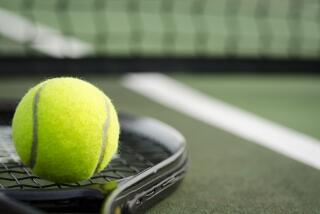Official Says ‘Ducking’ Opponents Is Too Common
- Share via
Eliot Teltscher estimates he and his archrival, Robert Van’t Hof, met more than 20 times during their junior careers. Teltscher and Van’t Hof were usually No. 1 and No. 2 in Southern California.
“Sometimes, we’d play in five to 10 finals a year,” said Teltscher, who along with Van’t Hof were top-30 players in the 1980s. “It was good for both of us. We needed each other. The way we took it then was, we’ll both get better.”
But that kind of rivalry and that philosophy don’t exist much anymore in junior tennis. If a highly ranked player faces a rival in a local tournament, it’s usually by accident. These days “ducking” a lower-ranked opponent to protect a ranking is becoming the norm and it sickens Teltscher, now the U.S. Tennis Assn. national coach for Southern California.
The best way to duck is to default out of a tournament with an injury or an illness. Players will pull out of a draw if they feel their ranking could be jeopardized by a loss to a lower-ranked player.
“I’d say 70% to 75% of the top players find a way to duck,” Teltscher said. “There’s so many defaults, it’s ridiculous. There’s no way all those kids are hurt.”
Mater Dei senior Melissa Esmero, ranked eighth in the Southern California Tennis Assn. girls’ 18s and 23rd nationally, said she has never ducked, but she knows players who have.
“It may seem like the easy way out, but it isn’t,” Esmero said. “You have to face your fears.”
But Esmero said she understands why some players are prone to ducking.
“If you feel like you’re not ready to play a tournament, you start to doubt yourself,” she said. “Sometimes, it is a smart thing to do. I know a lot of the top players go to Europe, come back and aren’t ready to defend their ranking.”
The reason so many players are protecting their rankings is the system itself. Rankings determine which players are picked for regional, national and international tournaments, which players are given money for travel expenses by the USTA and which players are sponsored by equipment companies such as Wilson, Prince and Adidas.
John Lansville, SCTA manager of player development, says many players will play five required local tournaments early in the season, access their ranking and then begin ducking lower-ranked opponents later in the year.
“A lot of it is the ranking system, but a lot is an attitude and the way of looking at things,” Teltscher said. “Part of that comes from the parents and the coaches. There’s enough blame to go around. What has to happen is the kid has to say, ‘I’m going to be a pro player and I have to handle the pressure.’ You can only avoid it for so long.”
Teltscher said the most blatant example of ducking is in the boys’ 16s, where most of the top 10 players have avoided facing each other this year. Teltscher said defaulting isn’t the only way to duck. Playing in a higher age group is also a common way to hold onto your ranking in your own age group.
Esmero said she believes a higher-ranked player ducked her once, but she had no proof.
“You don’t want to really judge somebody because they might really be injured,” Esmero said.
There is no perfect solution, but Lansville said the SCTA is toying with the idea of limiting the number of defaults per season. Teltscher doesn’t believe that should be necessary.
“If they spent more time practicing than figuring out how to duck, we’d have better players,” he said. “It doesn’t make anybody better if none of these players play each other.”
The current crop of elite American men came up together in the juniors--Pete Sampras, Andre Agassi, Jim Courier and Todd Martin. Teltscher believes they became the players they are by competing against each other locally and nationally as kids.
“Every one made the other guy better,” Teltscher said. “We need to get back to that. We have to learn to compete. The guys that make it can handle the pressure and face their toughest competition. I don’t think we’re as tough as the other guys now.”
Not every parent wants his child to be the next Pete Sampras. Some have a college scholarship as a goal, and a decent Southern California ranking can accomplish that goal.
So why not duck?
“Why wouldn’t every parent want their kid to be the best they can be, no matter where they’re going?” Teltscher asks.
Good question.
SPEAKING OF RANKINGS
With his second-place finish in last month’s boys’ 16s junior sectionals, Sunny Hills senior Joseph Kao improved from ninth to sixth in the SCTA and 17th nationally. Newport Harbor sophomore Natalie Braverman, who reached the finals of the girls’ 16s, remained seventh in the SCTA but improved to 33rd nationally.
In the girls’ 14s, Orange’s Lindsey Nelson is ninth nationally and second in the SCTA, and Irvine’s Anne Yelsey is 13th nationally and fourth in the SCTA. In the girls’ 18s, Corona del Mar senior Caylan Leslie is 18th nationally and fifth in the SCTA. The national rankings come into play on July 18 when the USTA Clay Court Nationals begin in the 14s, 16s and 18s.
LOCAL TOURNAMENT
The USTA men’s 50 and 55 hard court championships begin Monday at Lindborg Racquet Club in Huntington Beach. Brian Cheney of Chandler, Ariz., is seeded first in the 50s and Leland Hausman of San Diego is top-seeded in the 55s. Finals are scheduled July 18. Admission is free.
More to Read
Get our high school sports newsletter
Prep Rally is devoted to the SoCal high school sports experience, bringing you scores, stories and a behind-the-scenes look at what makes prep sports so popular.
You may occasionally receive promotional content from the Los Angeles Times.





